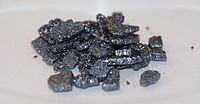
Photo from wikipedia
Abstract Recently, there has been increased interest in the development of novel antimicrobial compounds for utilization in a variety of sectors, including pharmaceutical, biomedical, textile, and food. The use, overuse,… Click to show full abstract
Abstract Recently, there has been increased interest in the development of novel antimicrobial compounds for utilization in a variety of sectors, including pharmaceutical, biomedical, textile, and food. The use, overuse, and misuse of synthetic compounds or derivatives have led to an increase of pathogenic microorganisms gaining resistance to the traditional antimicrobial therapies, which has led to an increased need for alternative therapeutic strategies. Seaweed are marine organisms that can be cultivated sustainably, and they are a source of polar molecules, such as pigments and phenolic compounds, which demonstrated antimicrobial potential. This review focuses on current knowledge about pigments and phenolic compounds isolated from seaweeds, their chemical characteristics, antimicrobial bioactivity, and corresponding mechanism of action.
Journal Title: Biomolecular Concepts
Year Published: 2022
Link to full text (if available)
Share on Social Media: Sign Up to like & get
recommendations!